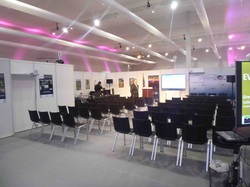Attendees hurriedly jostled for position through the main halls of QNCC, the home of the COP18 program, while darting in and out of meeting halls and individual focus groups. I dodged, bobbed, and weaved through the crowds as I tried to establish some semblance of a morning routine in order to plan the day. Sipping coffee and looking over the day’s program, I immediately starting creating a mental list of the events I wanted to learn more about. However, after each new talk or booth I attended, I was crossing off and amending the schedule. Thus, if I had to give a phrase that would best describe my initial experiences on what I would consider the first “real” day at COP18 it would be: “information overload.” Everything in the convention center, if taken all at once, could be considered overwhelming. The other bloggers and I attempted to divide and conquer the day’s events and attend as many talks as possible.

One of the first things I explored was the official pavilion for a variety of countries that opted to participate. While USA is typically chided for its position on climate change policy (which is actually a much more complex issue than it is given credit for), its role as the leader in climate research can’t be denied. While the USA does not agree on some of the market forces being proposed by the UNFCCC to regulate greenhouse gas emissions, its funded climate research drives much of the proposed legislation. The USA pavilion seen in the picture here, gave several presentations throughout the day hosted by a variety of institutions including the EPA and NASA including EPA’s role in monitoring and reporting mechanisms for greenhouse gas emissions in the USA. All of the talks at the USA Center are posted online and streamed live here.

Perhaps the most interesting aspect of the USA pavilion was the NASA Hyperwall (it even sounds cool), which was a huge TV that was loaded with a variety of climate related data and models. All of the data and models are freely distributed over the web and can be found here. Its mission is to enhance data outreach through visualization techniques, which I found extremely interesting a refreshing take on simply publishing hoards of data. Another outcome of my discussions at the NASA Hyperwall are based on the measurement of the isotopic dilution of carbon-13 in the atmosphere, but deserves its own blog at a later date.

The Gulf Cooperation Council (GCC, including countries such as Qatar, Saudi Arabia, and Kuwait among others) got the award for the best decorated pavilion stocked with waiters, free coffee, and swanky architecture. However, in all seriousness the GCC has done a great job in sharing some of its efforts in carbon capture, enhanced oil recovery, and other techniques designed for higher efficiency and a net decrease in greenhouse gas emissions.
A second point I’d like to highlight would be the market-based mechanisms for creating a net decrease in greenhouse gas emissions, which is I believe the biggest driver in countries not signing the Kyoto protocol originally and the reason why a new protocol has not been agreed upon yet. While it is generally implied that the countries that did not sign the Kyoto protocol simply did not want to cut greenhouse gas emissions or did not believe it was necessary, in many cases the bigger sticking point was and still remains on how this would be done and its regulation.
In order to simplify the blog post, I will overgeneralize the various viewpoints in order to discuss them more informally. The goal of the carbon market mechanism is to assist DEVELOPED countries for meeting greenhouse gas emission reductions. Two main ways this is accomplished is through two strategies sectoral crediting and sectoral trading. Sectoral crediting is the process of awarding credits or rewards for meeting defined goals. Sectoral trading is establishing a trade system that assigns fines for not meeting reducing goals, but is not necessarily a cap and trade system. While each country has its own strategy to help drive market mechanisms (or if they are needed), an area coming under intense scrutiny is in how these systems will be overseen and implanted.
There are essentially two main and polar opposite approaches: a top-down approach or a bottom-up approach. In the top-down approach, the UNFCCC acts as a governing and legally binding entity with a more centralized framework. Many developing nations and the EU favor this type of an approach as it allows for continuity, common accounting practices, and common environmental integrity as a single body is evaluating the technical merit and emissions reduction. The UNFCCC would then be responsible for issuing credits and fines. An opposing view would be the bottom-up approach, which allows each individual country to set its own methods to reduce greenhouse gas emissions and issue its own credits and fines. This strategy is favored by the USA, Japan, and New Zealand. However, the UNFCCC argues that this will lead to carbon market fragmentation with different values for the credits and fines as well as inconsistent environmentally integrity. A recent paper, linked here, discusses the challenges and all of the potential design strategies to reach a framework consensus. Unfortunately, of all the people I heard speak today, none were expected any major decision with regards to the carbon market mechanism, which continues to act as burden to industries seeking regulation certainty.
As I mentioned in an earlier blog, the USA (and most of the industries around the world) will not commit to any greenhouse gas emissions until it is economically viable and consistent. This is why the USA continues to lead in research and development, but has not yet committed to an exact greenhouse gas emission reduction.
In order to simplify the blog post, I will overgeneralize the various viewpoints in order to discuss them more informally. The goal of the carbon market mechanism is to assist DEVELOPED countries for meeting greenhouse gas emission reductions. Two main ways this is accomplished is through two strategies sectoral crediting and sectoral trading. Sectoral crediting is the process of awarding credits or rewards for meeting defined goals. Sectoral trading is establishing a trade system that assigns fines for not meeting reducing goals, but is not necessarily a cap and trade system. While each country has its own strategy to help drive market mechanisms (or if they are needed), an area coming under intense scrutiny is in how these systems will be overseen and implanted.
There are essentially two main and polar opposite approaches: a top-down approach or a bottom-up approach. In the top-down approach, the UNFCCC acts as a governing and legally binding entity with a more centralized framework. Many developing nations and the EU favor this type of an approach as it allows for continuity, common accounting practices, and common environmental integrity as a single body is evaluating the technical merit and emissions reduction. The UNFCCC would then be responsible for issuing credits and fines. An opposing view would be the bottom-up approach, which allows each individual country to set its own methods to reduce greenhouse gas emissions and issue its own credits and fines. This strategy is favored by the USA, Japan, and New Zealand. However, the UNFCCC argues that this will lead to carbon market fragmentation with different values for the credits and fines as well as inconsistent environmentally integrity. A recent paper, linked here, discusses the challenges and all of the potential design strategies to reach a framework consensus. Unfortunately, of all the people I heard speak today, none were expected any major decision with regards to the carbon market mechanism, which continues to act as burden to industries seeking regulation certainty.
As I mentioned in an earlier blog, the USA (and most of the industries around the world) will not commit to any greenhouse gas emissions until it is economically viable and consistent. This is why the USA continues to lead in research and development, but has not yet committed to an exact greenhouse gas emission reduction.
 RSS Feed
RSS Feed